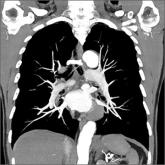Article

A Better Approach to the Diagnosis of PE
- Author:
- Andrew H. Slattengren, DO
- Shailendra Prasad, MBBS, MPH
- David C. Bury, DO
- Michael M. Dickman, DO
- Nick Bennett, DO
- Ashley Smith, MD
- Robert Oh, MD, MPH, FAAFP
- Robert Marshall, MD, MPH, MISHM, FAAFP
A simple diagnostic algorithm is all that’s needed to safely and effectively reduce reliance on CT pulmonary angiography to diagnose pulmonary...
Article

Can Vitamin D Prevent Acute Respiratory Infections?
- Author:
- Bob Marshall, MD, MPH, MISM, FAAFP
- Nick Bennett, DO
- Ashley Smith, MD
- Robert Oh, MD, MPH, FAAFP
- Jeffrey Burket, MD, MBA, FAAFP
A systematic review and meta-analysis say “Yes”—but the dosages used may not be what you’d expect.
Article

A better approach to the diagnosis of PE
- Author:
- Andrew H. Slattengren, DO
- Shailendra Prasad, MBBS, MPH
- David C. Bury, DO
- Michael M. Dickman, DO
- Nick Bennett, DO
- Ashley Smith, MD
- Robert Oh, MD, MPH, FAAFP
- Robert Marshall, MD, MPH, MISHM, FAAFP
A simple diagnostic algorithm is all that’s needed to safely and effectively reduce our reliance on CT pulmonary angiography to diagnose PE.
Article

Can vitamin D prevent acute respiratory infections?
- Author:
- Bob Marshall, MD, MPH, MISM, FAAFP
- Nick Bennett, DO
- Ashley Smith, MD
- Robert Oh, MD, MPH, FAAFP
- Jeffrey Burket, MD, MBA, FAAFP
A systematic review and meta-analysis says Yes, but the dosages used may not be what you’d expect.
